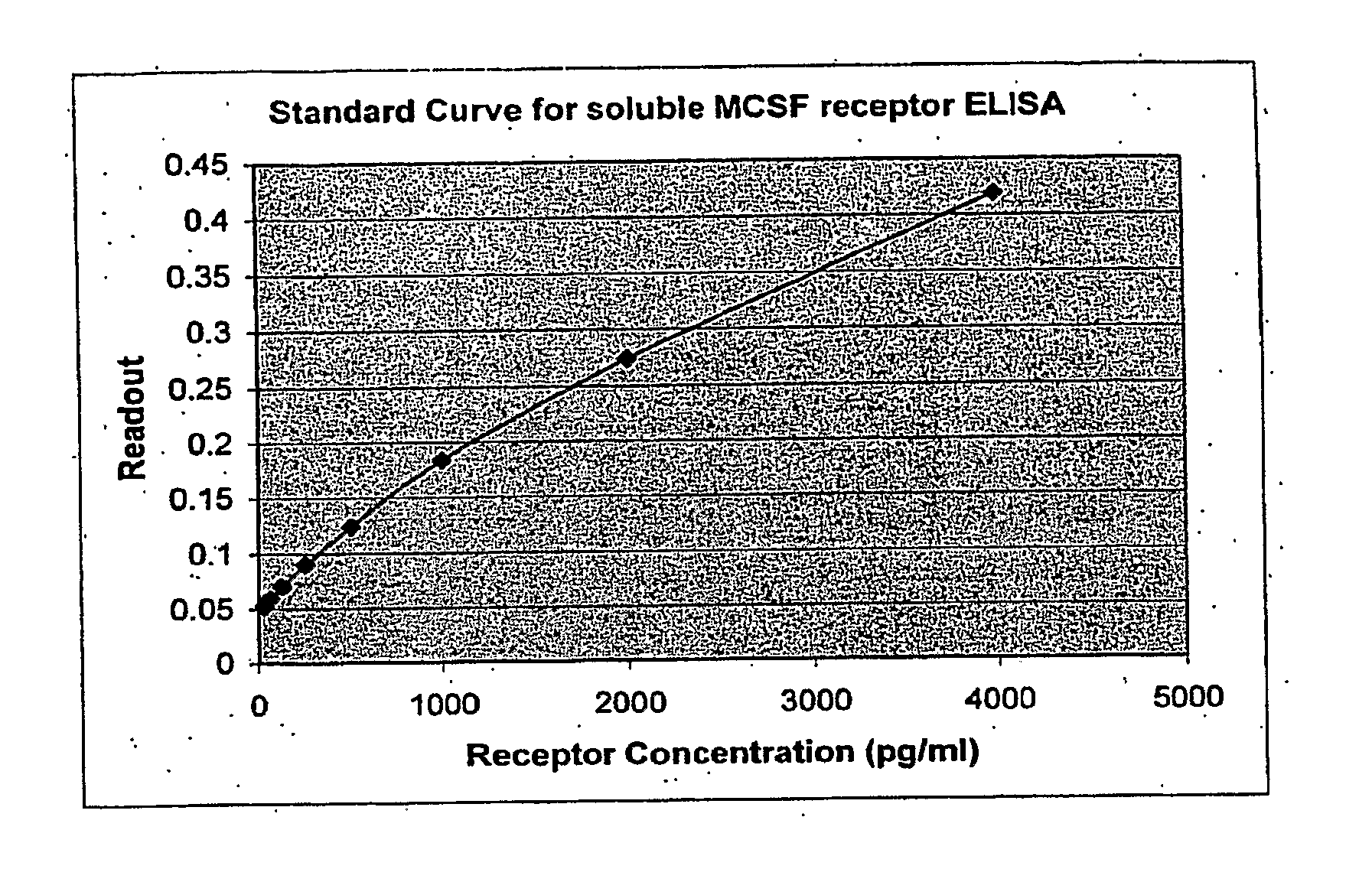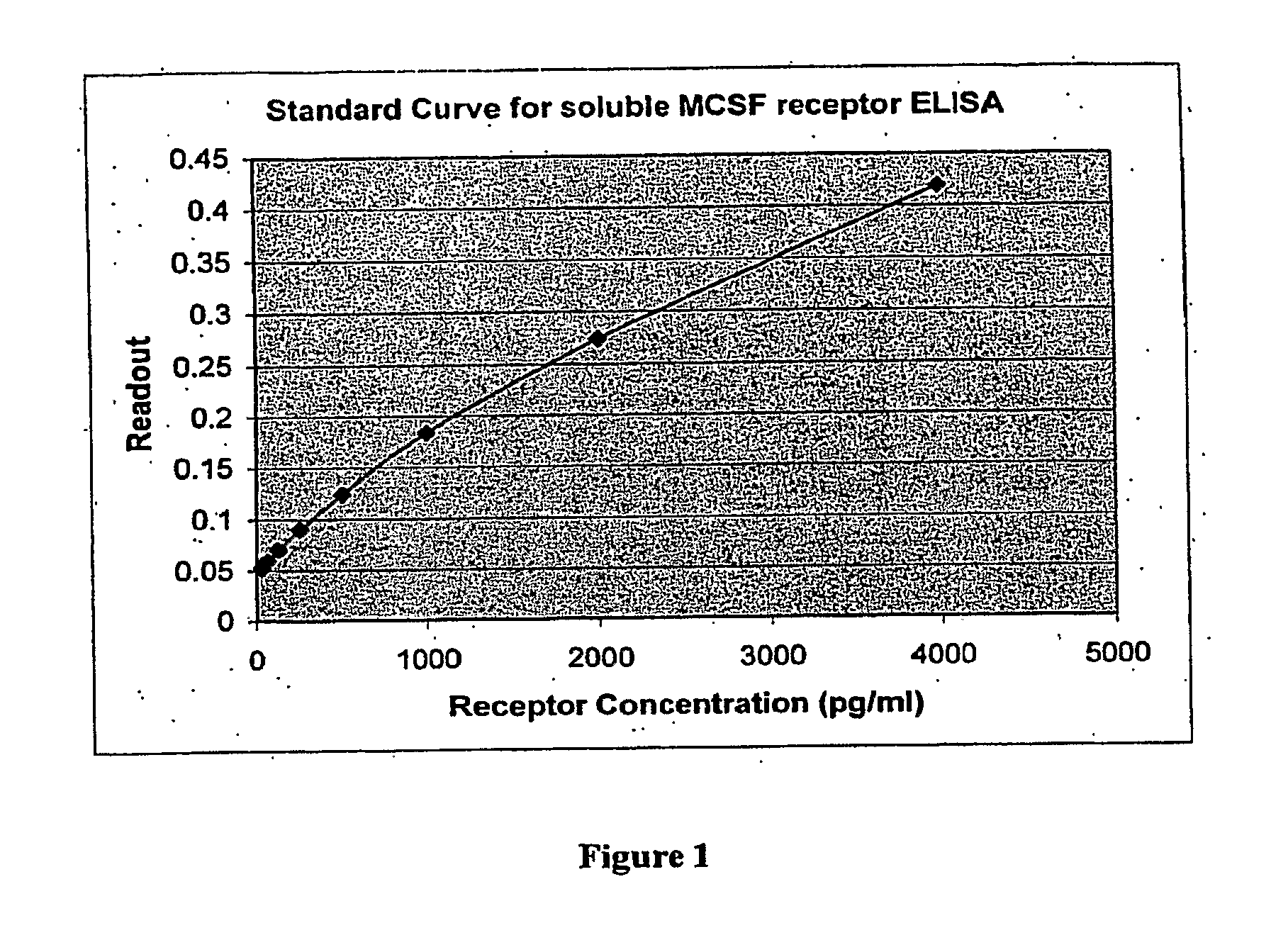Soluble Human M-CSF Receptor and Uses Thereof
a human mcsf and receptor technology, applied in the field of soluble human mcsf receptors, can solve the problems of significant increase in cancer morbidity and mortality
- Summary
- Abstract
- Description
- Claims
- Application Information
AI Technical Summary
Benefits of technology
Problems solved by technology
Method used
Image
Examples
example 1
[0093]This example describes the identification of a soluble receptor for human M-CSF and shows that this soluble receptor is capable of binding M-CSF.
[0094]I. Identification of Soluble Human M-CSF Receptor in Serum Samples
[0095]A. Materials and Methods
[0096]Micro titer plates (R&D systems, Cat# CP0011) were coated with 100 μl / well capture antibody (Duo Set Elisa development system hM-CSF R(R&D systems, Cat# DY329)) at a working dilution of 100 ng / ml in PBS. The plates were sealed and incubated at room temperature overnight. After washing the wells 3 times with wash buffer (0.05% Tween in PBS, pH 7.2-7.4) with a manifold dispenser / washer, plates were blocked with 300 μl / well of blocking buffer (1% BSA, 5% Sucrose in PBS, pH 7.2-7.4) at room temperature for at least 1 hour.
[0097]After repeating the wash step, the plates were ready for sample addition. 100 μl / well of either sample or standards in reagent diluent were added. Plates were covered with adhesive and incubated for 2 hours a...
example 2
[0115]This Example shows that the soluble M-CSF receptor was found in human urine samples. This Example further shows that this receptor is present in serum from both normal subjects and breast cancer patients, and the soluble M-CSF receptor level correlated with the M-CSF level. Finally, this Example shows that the soluble M-CSF receptor is also found in primates.
[0116]I. Soluble Human M-CSF Receptor was also Found in Urine Samples
[0117]Using the same ELISA setup as described in Example 1, multiple urine samples from healthy human volunteers were collected and assayed for the presence of soluble human M-CSF receptor. Varying levels of soluble human M-CSF receptor were detected among adult female (age from 25 to 66), adult male (age from 35 to 70) and children from age 3 to 9. Quantification of the concentration of soluble human M-CSF receptor was determined with recombinant c-fms-human Fc fusion protein as reference (FIG. 9).
[0118]Urine samples were collected daily throughout the m...
example 3
[0125]This Example shows that the expression of soluble human M-CSF receptor is tightly coupled with osteoclast differentiation. This Example further shows that only differentiated osteoclasts express the soluble human M-CSF receptor, the level of which increases upon removal of M-CSF.
[0126]A. Materials and Methods
[0127]The expression of M-CSF soluble receptor was studied in an in vitro system with human osteoclast cells, where the expression of the membrane-bound M-CSF receptor was found. In particular, the expression of the soluble receptor was examined in the context of osteoclast differentiation. Primary human Osteoclast Precursors (Cambrex Bio Science Walkersville, Inc. Cat# 2T-110) were seeded at 10,000 cells / well at 0.2 ml / well in the cell culture media containing 30 ng / ml human M-CSF and 100 ng / ml RANKL. Test antibodies were added to the wells at 1 μg / mL on the same day of cell plating. The cells were incubated at 37° C., in a humidified atmosphere of 5% CO2. On day 7, osteo...
PUM
 Login to View More
Login to View More Abstract
Description
Claims
Application Information
 Login to View More
Login to View More - R&D
- Intellectual Property
- Life Sciences
- Materials
- Tech Scout
- Unparalleled Data Quality
- Higher Quality Content
- 60% Fewer Hallucinations
Browse by: Latest US Patents, China's latest patents, Technical Efficacy Thesaurus, Application Domain, Technology Topic, Popular Technical Reports.
© 2025 PatSnap. All rights reserved.Legal|Privacy policy|Modern Slavery Act Transparency Statement|Sitemap|About US| Contact US: help@patsnap.com



